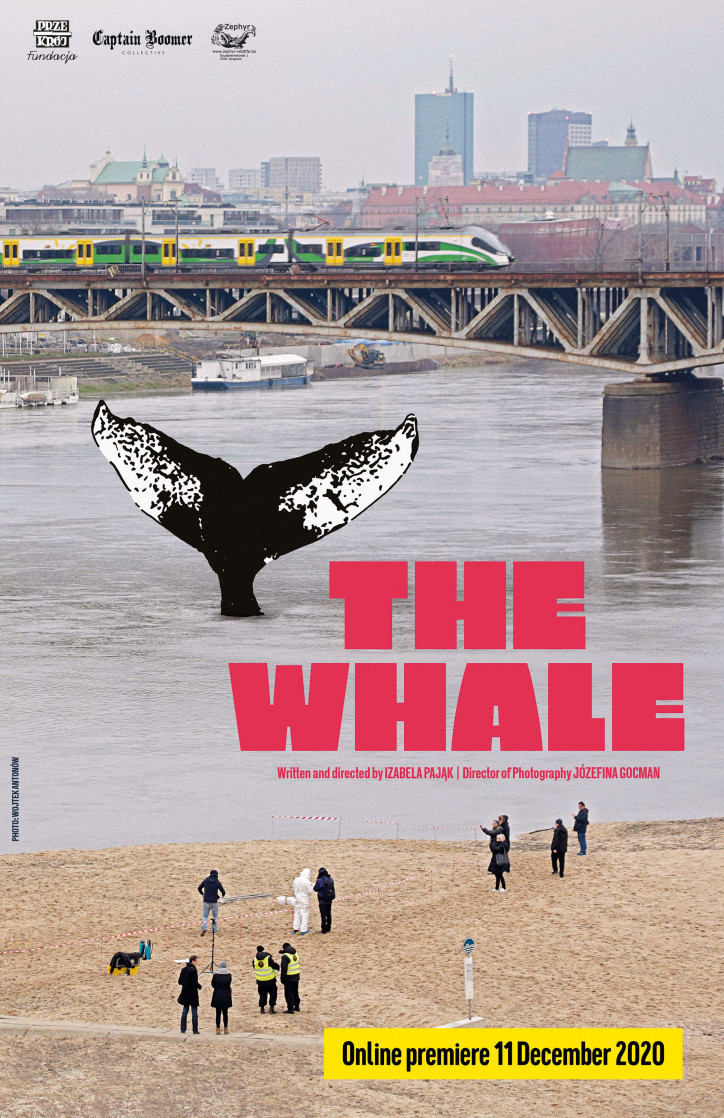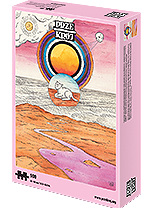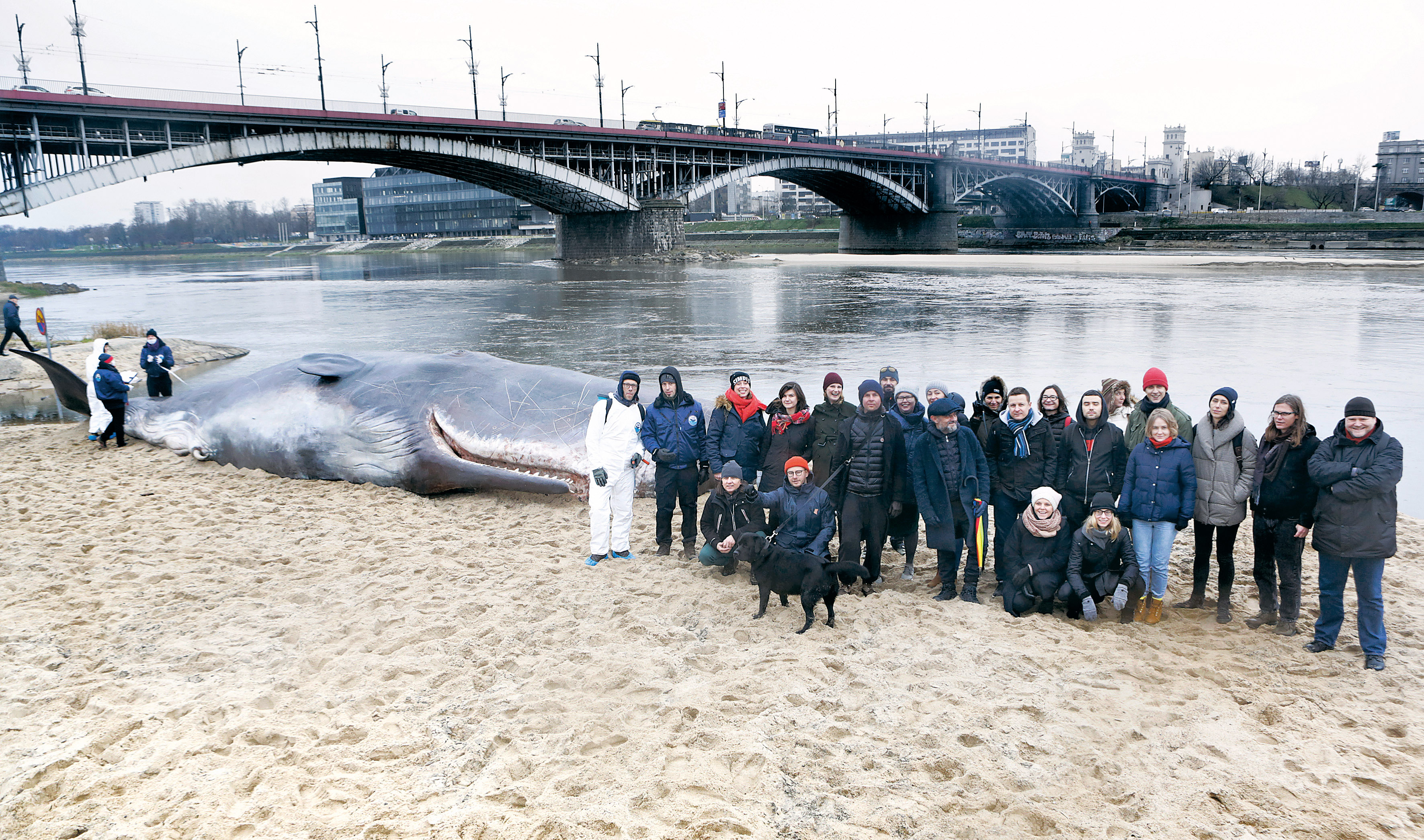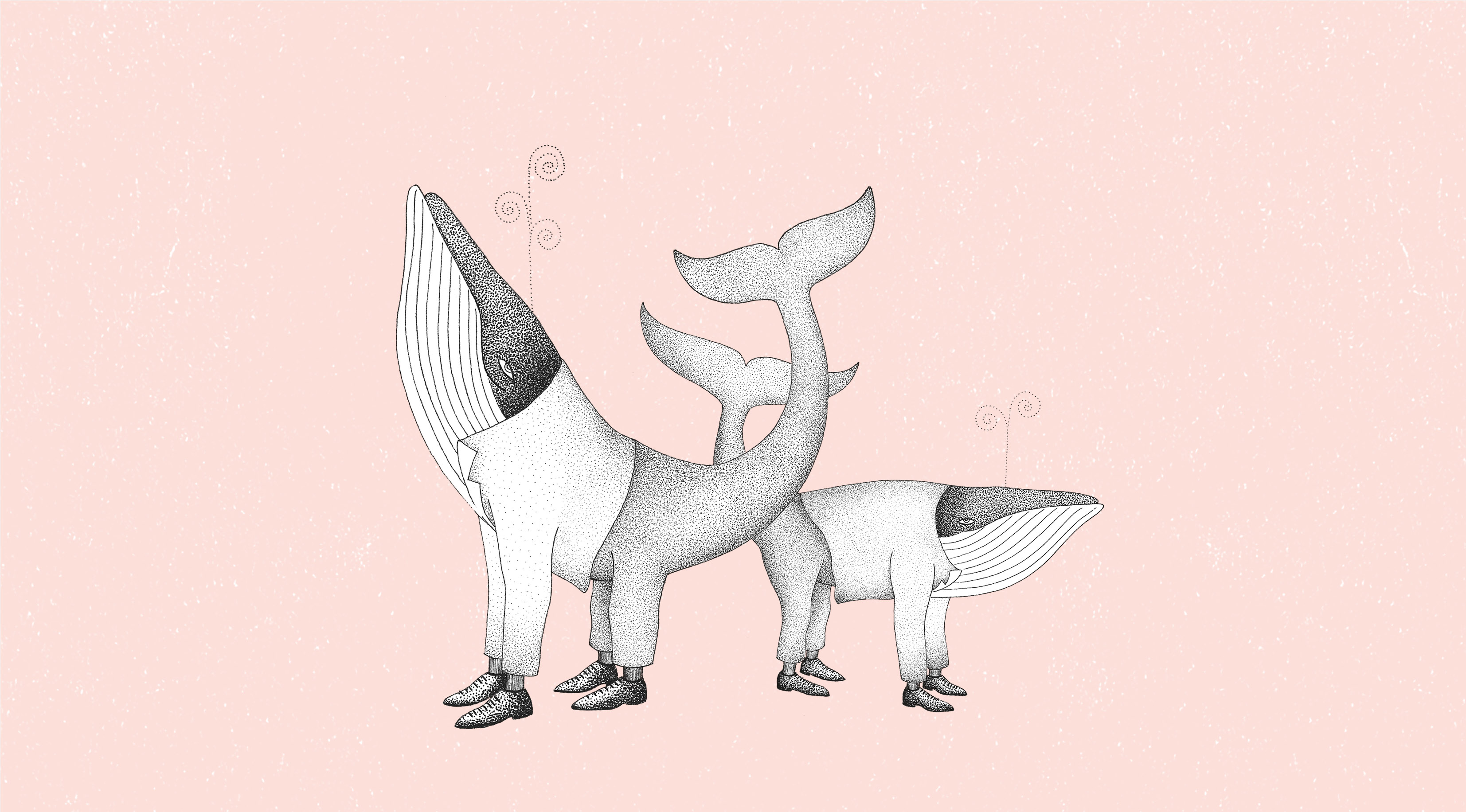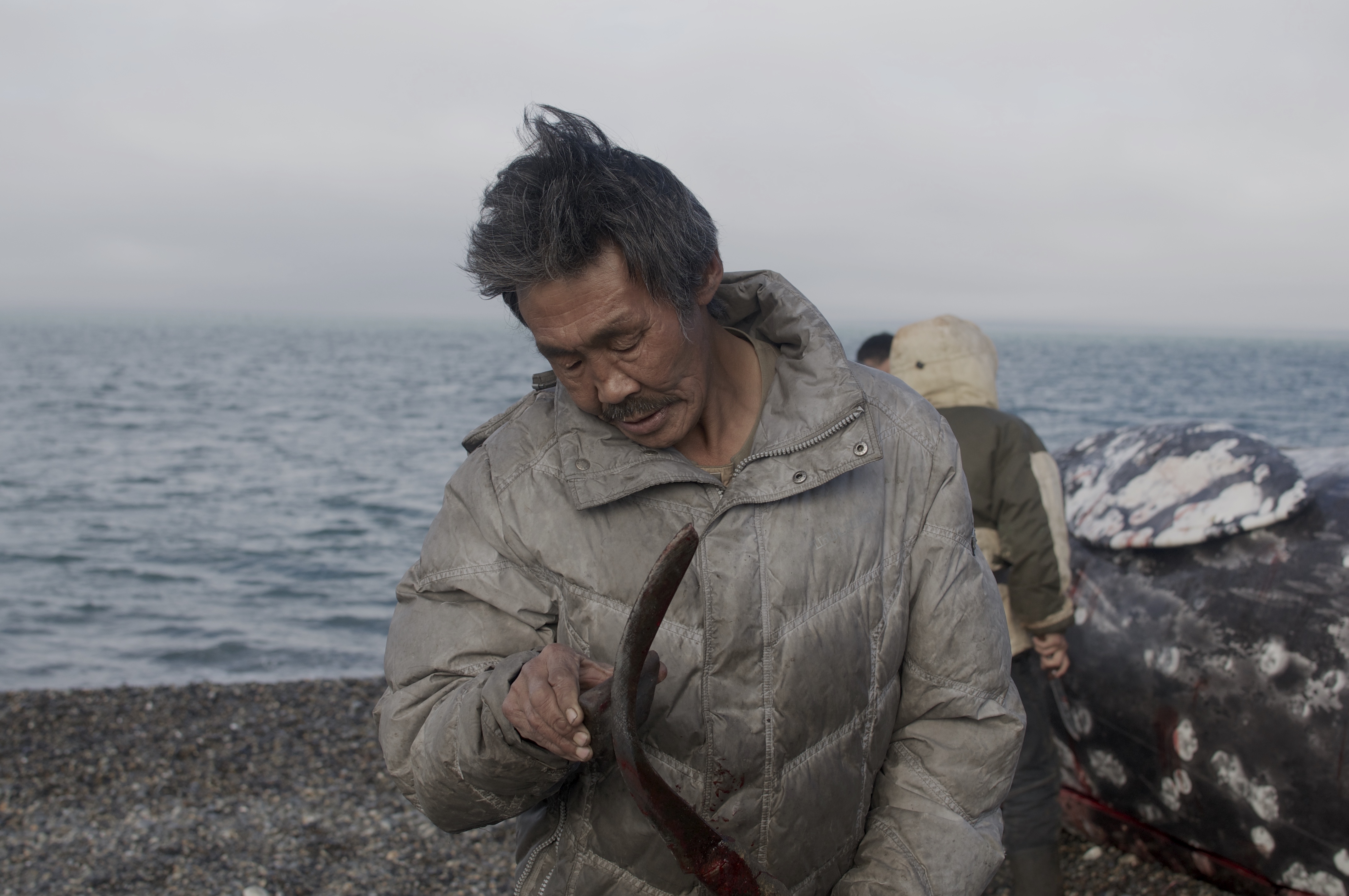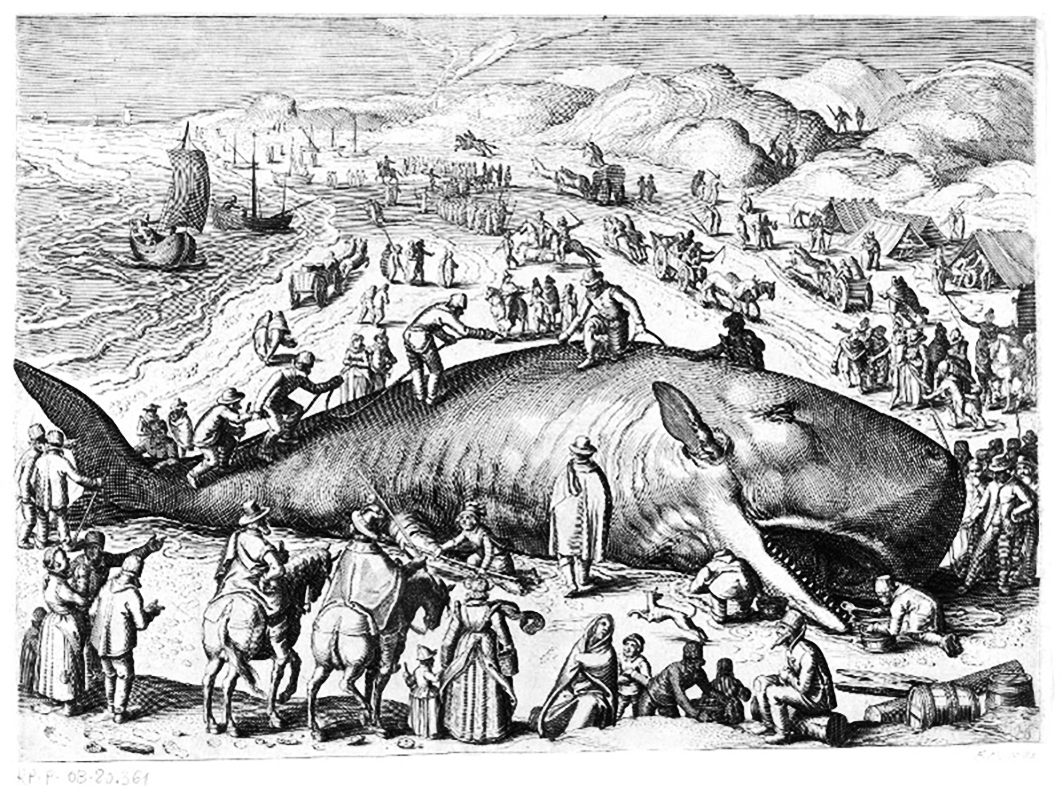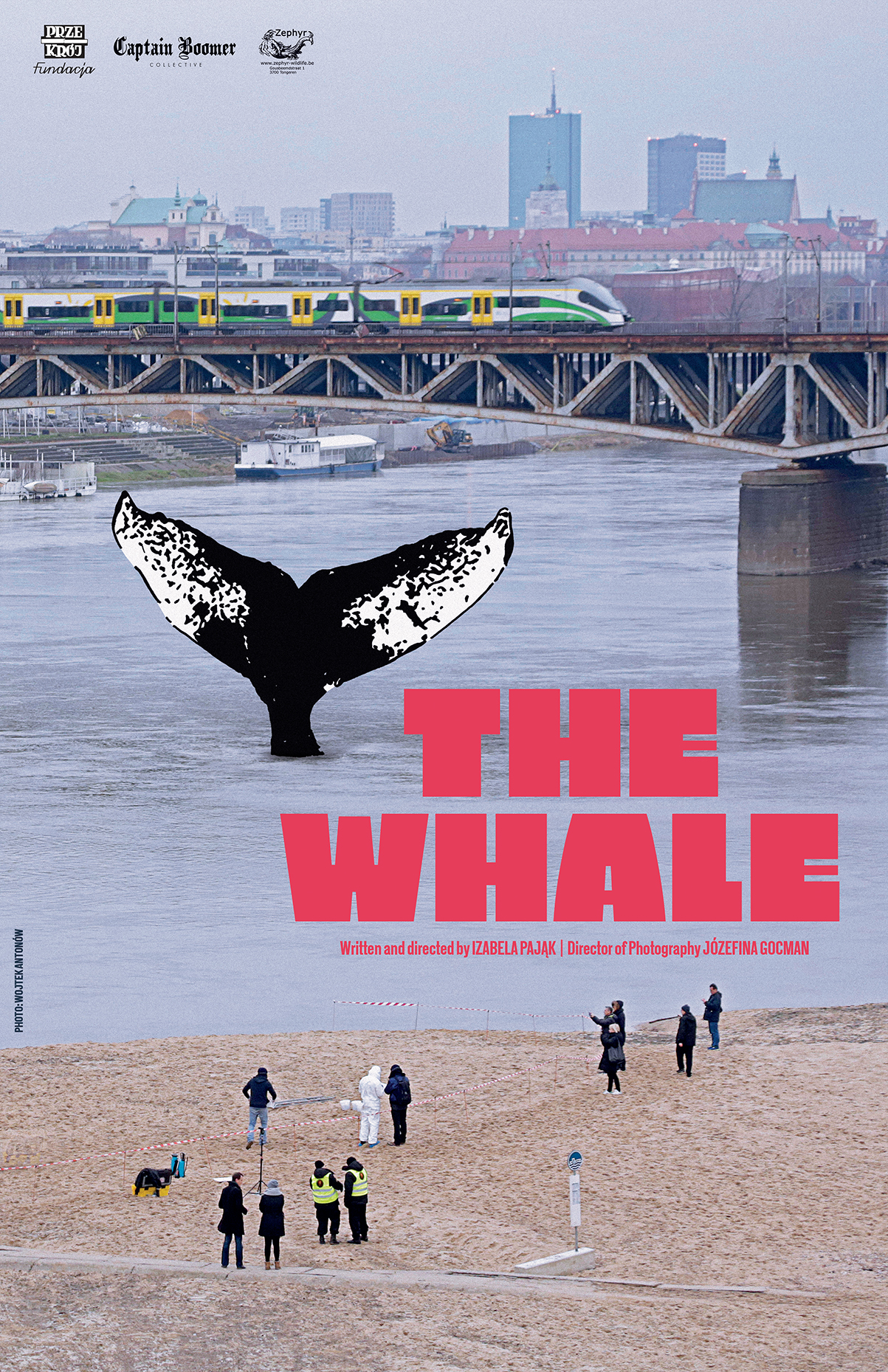
For now it’s still a secret, but PRZEKRÓJ Foundation and the Captain Boomer collective are planning another project together. I talked to Bart Van Peel, who is the originator of the Belgian art collective’s projects. We discussed, among other things, the whale that aroused curiosity and inspired awe on a Vistula riverbank three years ago.
In December 2017, the figure of a several-metres-long whale washed up on a riverbank in Warsaw. As time passed by, it turned out that the whale was actually a sculpture by the Belgian collective Captain Boomer, which had been brought to Warsaw by our quarterly magazine.
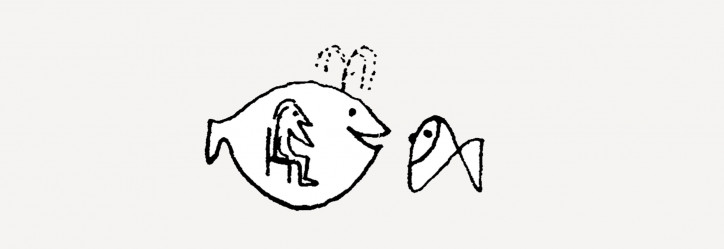
Łukasz Kaniewski: How was the idea for the whale born? What is the main theme of this performance for you: ecology or death?
Bart Van Peel: I live about one hour from the sea and about every 10 years it happens that a sperm whale throws itself on the Belgian coast and dies there. Thousands of people go to see it. And you have that very dramatic encounter of this giant from the deep sea, powerless on land, and the powerless people standing around. It has always struck me as a primordial scene. Extreme, beautiful, mysterious.
I remember that I started telling everyone about the idea of a reconstructed whale beaching. I wanted to reconstruct that into every detail. My friend and our producer Stijn Doggen was also excited, and he suggested contacting the brilliant animal sculptor Dirk Claessen. The rest is history.
The first urge was just beaching the whale. Getting it done. We wanted to see what happened. Since we fenced it, just like with a real whale beaching, people were unable to verify if it was real. And our actors did a brilliant job investigating the carcass and giving the installation the authority of science and uniforms.
The fact that it is fake made the social dynamic even more interesting. Especially when people start questioning their own thoughts and emotions. Some people were crying, others felt full of guilt. When they found out it was fake, some were angry. Others thought it was funny or were relieved. People started feeding the illusion to each other and it really became a place where everyone gets together and wonders.
The press always wants fast answers, so it was seen as a sort of ecological statement. We didn’t contradict that. You have to agree that urgent action is necessary to mitigate our disastrous behaviour on this planet. And this giant throwing itself at our feet is a powerful image of nature saying: “I can’t take it anymore. I’m exhausted.” So that conclusion is welcome, but to be honest, it was never the first thing for me. It is the magic of encountering a monster from the deep, from another element. The memento mori it screams at a whole city. The fact that you disturb the status quo and you make people doubt their senses.
Your artistic ideas, such as the whale, seem very difficult to implement. How do you go about implementing them? Do you approach the matter coolly and systematically, or do you try to arouse enthusiasm?
Well, fortunately, I also have ideas that are less challenging, in terms of production. For a poem you only need a pen. But it is true, I have a tendency towards the grandiose and the impossible. I have a few good friends who will listen to new ideas. They are artistic people with a pragmatic edge. When their eyes shine, I know that we are on to something.
Personally, I am not very systematic in my methods. Every email, every phone call, every action seems to be done on an impulse. And yet when you look back, there seems to be a system. I consider the whole matter of organizing, marketing yourself, fundraising etc. part of the artistic process. But maybe I just say that to keep it interesting for myself.
I learned gradually to think more practically. However, it will never be my first talent. The hardest thing about the big projects is the patience you need. Enthusiasm is indeed crucial. If you and the people working on the project are not excited and think it is meaningful, why bother? That’s why Captain Boomer is a collective. It really is a team effort.
Do you sometimes come up with ideas that seem great to you but are impossible to implement? Can you give me an example?
About 50% of our projects don’t work out. Money, safety, regulations, technical problems, conflicts, artistic deadlock sometimes stand in the way.
For example, across the last three years we tried to build the highest cathedral in the world – from cardboard. I am not kidding. It was a monumental failure in the end, but I loved every minute of it. Quite a lot of projects fail, sometimes after a great deal of work. But it is the nature of our imagination, we try to make the impossible possible. I have a few film plans that failed, half-written novels, unfinished songs – it is a graveyard of broken dreams out there. Yet sometimes, one of those zombie projects comes to life again. The most important thing is to keep on going and be nice to the people you work with.
Are your art projects supposed to provoke emotions or rather make people think?
If people want to draw explicit conclusions, moral or political, from the installations, fine. But we will not draw those conclusions for them. I see the works sometimes as booby traps of meaning. You are lured in by sensation and beauty. And then you find yourself almost forced to take a stand, because you are engaged.
I also like it when people are confused, but can’t run away. Well, ideally it is like exploring new mental territory. Emotions that were not felt before and thoughts and connections that were not made before. I hope to create beauty that transcends and mesmerizes. Whether my work reaches that is for the audience to decide.
What do you think imagination is? What role does it play in the Homo sapiens species?
“Imagine there is no country,” as John Lennon sang. And you can indeed make that notion disappear just by imagining. Every great thing was done by imagination. A project is quite literally something you project into the future with your imagination. The best imagination is when you just follow a hunch. You have not imagined it yet, but you imagine the road that may lead you there. It is like when you write music. All of a sudden there is a chord or a tune that asks for more. You only know what you were looking for at the moment you find it.
I remember from the Warsaw edition of “Whale” that you tried to complement the audience’s experience with the smell of fish. Why? Is it your ambition to create art that appeals to all the senses?
A dead whale smells, so we needed to create this smell. In Warsaw, this was a bit harder because it was cold (we did the show in December) and the smell of rotten fish did not carry as far as when it is hot. Also, a dead whale has a very particular and completely different smell than rotten fish. But the audience doesn’t know that.
We try to use all the senses to come as close to the audience as possible. With the show “SKAGT”, which played in Paris and London in 2018, we took the audience on an extreme trip to the underworld. We had to come up with a ‘decompression room’ after the show to let people vent their emotions. It is a really short show, about 15 minutes long, but every sense is stimulated and submerged in illusion. The great thing about meeting the audience in reality (versus through online or screen content) is that you can make things much more concrete for them, so you can sometimes get under their skin.
I heard that you are also a teacher. If you could teach children only one thing, what would it be?
Curiosity.
Parts of this interview have been edited and condensed for clarity and brevity.
On the morning of 8th December 2017, those inhabitants of Warsaw on their way to work and school simply couldn’t believe their eyes. They were awestruck by what they saw on a sandy Vistula riverbank, just by Poniatowski Bridge in the city centre. A huge, motionless creature was lying there – a 15-metres-long whale. Before we revealed that the sperm whale was actually a sculpture created by the Belgian art collective Captain Boomer, brought to Warsaw by the “Przekrój” quarterly team, we managed to achieve our goal. This sculpture provoked people to stop, be surprised and pose questions. Is it real? How on Earth did it get here? Is it because of us?, people wondered.
Three years later, on 11th December 2020, we share on our website a short documentary directed by Iza Pająk about the events of that day. It portrays our society and shows how close we are to ecological disaster at the moment. For the past two years, we have been presenting the film at various film festivals, which is why we weren’t able to show it to a broader audience any earlier.
The festival round proved to be very successful. The film has won awards all over the world – among others, it was given the Audience Award for Best Experimental Short at Red Rock Film Festival in 2018, it won Best Short Documentary at Canberra Short Film Festival in 2018, and it came back from the Sebastopol Documentary Film Festival with the Jury Award for Best Mini Doc Film in 2020.
We invite you to watch The Whale on our website.
